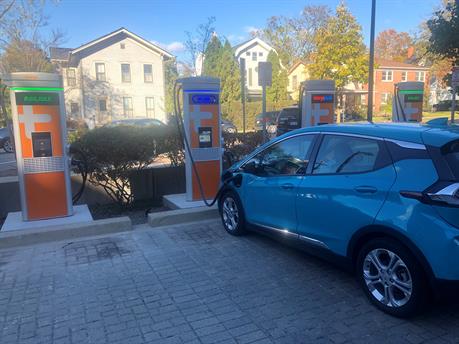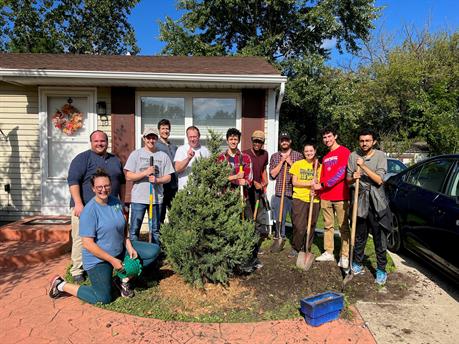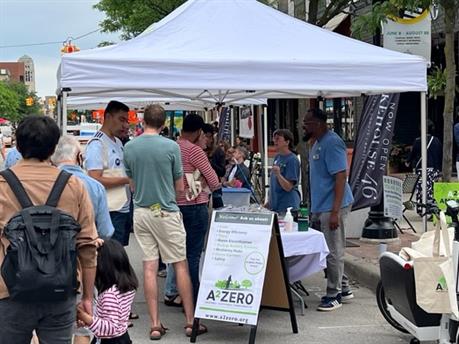Welcome
On the November 2022 general election ballot, Ann Arbor residents overwhelming voted in favor (71%) on a millage related to the community's investment in climate action. The ballot text is shown below. To see an update on the City's climate action work, please see our
reporting dashboard or sign up for our
monthly newsletter.
ANN ARBOR CITY CHARTER AMENDMENT
TAX FOR COMMUNITY CLIMATE ACTION
Shall the Charter be amended to authorize a tax up to 1 mills to fund community climate action for 2023 through 2043, which will raise in the first year of levy the estimated revenue of $6,800,000? In accordance with State law, a portion of the millage may be subject to capture by the Ann Arbor Downtown Development Authority and the Washtenaw County Brownfield Redevelopment Authority.
Authorized uses include: year-round composting; expanded residential/multifamily recycling; community and rooftop solar programs; rental and low-income household energy programs; bicycle, pedestrian and transit infrastructure; neighborhood resource centers; electric vehicle infrastructure; and tree plantings.
Yes No

Frequently Asked Questions
1. What is the Community Climate Action Millage?
The Community Climate Action Millage is a request for funding to support the city's ambitious climate and equity goal – achieving a just transition to community-wide carbon neutrality by 2030. The millage would provide the resources needed to immediately begin creating, implementing, and scaling programs and services to make progress locally and regionally towards this goal.

2. What will the millage support?
The millage will:
- Create, enhance, and provide services that move the city toward a zero waste, circular economy. This includes efforts to expand and increase use of composting, recycling, and reuse services and programs, support for local and sustainable food generation and use, construction waste recovery programs, and enhancement of reuse programs and services.
- Advance the deployment and utilization of renewable energies such as solar and geothermal in the community. This includes educational activities, community solar programs, bulk discount programs, low-income renewable energy programs, and other programs that help lower and/or remove barriers to accessing renewable energy, especially for low-income households. Monies may be used for the design and construction of renewable energy installations at municipal and public sites, including installations designed to be community solar programs.
- Support energy efficiency and weatherization programs designed to support residents and businesses in improving the energy and water efficiency of their homes and businesses while also improving comfort and affordability. This includes things such as programs to help seniors age in place, greening rental infrastructure, expansion of weatherization services, green business programs, and the creation of an energy concierge service.
- Advancing neighborhood and community resilience and preparedness to climate change and natural disasters. This includes efforts to foster neighborhood community and resilience centers, neighborhood emergency preparedness activities, flood and heat monitoring and mitigation support services, and community resource sharing.
- Create and sustain home- and transportation-related electrification programs. This includes support for building and installing electric vehicle charging stations at public sites, multi-family residential sites, and in commercial areas throughout the city as well as education, training, and programs focused on supporting appliance and vehicle electrification, including fleet electrification. This also includes programs and services aimed at lowering resident upfront costs to accessing electrified transit and transportation, especially for low-to-moderate income households.
- The 2023 Community Climate Action Millage may be used to support educational efforts as well as all administrative and ancillary costs required to complete the aforementioned programs and services and administer such programs and services.
- In addition, the millage may be used as local cost share to state, federal, and private grants where necessary to unlock additional financial resources.
3. If passed, what kinds of services or incentives would the millage support in its first five years?
If passed, the first five years of the millage would provide funding to:
Move toward zero waste with:
Year round commercial and multi-family recycling (annual landfill diversion approx. 2,400 tons)
Year round commercial and multi-family composting (annual landfill diversion approx. 1,500 tons).
New construction and demolition waste reduction program
Lower energy costs with:
Proposed direct rebates for home and business energy improvements for:
Energy waste reduction / efficiency improvements (e.g., insulation, air sealing)
Renewable energy installations (e.g., solar, geothermal)
Appliance electrification (e.g., heat pumps, water heaters, induction stoves)
Energy storage systems and electrical panel upgrades
A new Energy Concierge to help individual homes/businesses identify cost savings and comfort, health, and safety improvements.
Improve community resilience with:
40MW+ of clean, renewable, reliable energy
100+ units of net zero affordable housing
2 neighborhood resilience centers
100+ rain gardens and 10,000 trees
5,000 emergency preparedness kits and plans.
Increase walking and biking safety with:
4. How much would the millage increase my taxes?
If approved, the 1-mill amounts to $125 annually for a property with an average taxable value of $125,000.
5. What's the difference between taxable value and assessed value?
In Michigan, property is assessed at 50% of fair market value and property taxes are calculated on taxable value. Assessed values change annually based on market conditions of property. Taxable values changes are capped by the rate of inflation. The maximum change in taxable value for one year is 5%. For the past several years, the inflation rate has been less than 2.5%. The one mill levy that is being proposed will be calculated off the taxable value of property, not the assessed value. A property owner can also look up assessed and taxable value using the online assessment and property tax data search tool through the city of
Ann Arbor website.
6. Is this a permanent tax?
No, this millage is being requested for 20 years.
7. What is A2ZERO?
Adopted by City Council in June 2020,
A2ZERO is the city's climate program, plan, and associated services that focus on achieving a just transition to community-wide carbon neutrality by the year 2030.

8. Why not conduct a millage at the County level?
The city doesn't have the authority to put a county-wide millage on the ballot, only the Washtenaw County Commissioners or county residents do. However, the city plans to use the millage to create new initiatives and programs that are scalable and have the potential to be replicated by other local units of government. Moreover, the County, as well as many surrounding municipalities, are members of the
A2ZERO collaborators network where we share experiences, lessons learned, and explore collaboration opportunities as it relates to creating a just transition to carbon neutrality.
9. Why is the City looking to fund climate work, at least in part, through a millage?
In Michigan there are very few ways that local governments can raise revenue, and one of the few viable pathways is through millages. Right now, funding does not exist at the scale needed to address local climate change-related needs and create local climate programs. The City continues to pursue federal grants, state support, philanthropic dollars, and donations to advance climate work, but a millage provides a guaranteed and regular source of funding.

10. How much revenue would it generate?
In 2021 dollars, the Millage, which is up to 1-mill, would generate an estimated $6.8 million per year for 20 years.
11. Have other municipalities passed similar millages?
Numerous communities have passed millages or comparable funding mechanisms to fund their local climate efforts, including:
On November 3, 2020, Denverites passed Ballot Initiative 2A raising the local sales and use tax by 0.25% to create the Climate Protection Fund (CPF), which raises $40 Million annually to address climate change.
In 2016, voters in Boulder County passed a sustainability tax (sales and use tax) to support climate action, renewable energy, sustainable transportation, circular economy and waste reduction, water conservation, and local food production and use.
British Columbia has had a carbon tax since 2008.
Alberta, Canada implemented a carbon tax in 2017 on emissions not covered by its existing carbon pricing program.
In 2006, the City of Boulder, Colorado, became the first U.S. city with a direct voter-approved carbon tax.
Athens, Ohio passed a carbon fee that is placed upon utilities, set at a rate of 2-mills per kilowatt hour ($0.002/kWh), which adds up to an increase of $1.60-$1.80 on an average household's utility bill each month, and funds primarily solar projects.
Aspen was the first city in the world to introduce a carbon fee in 1999, called the Renewable Energy Mitigation Program (REMP). It requires either onsite mitigation with renewables or charges a 'fee-in-lieu' on new buildings and large remodeling projects that consume excess energy. REMP uses those revenues for grants and rebates that fund energy efficiency and renewable energy measures.
Orange County, North Carolina passed the Orange County Climate Action Tax, a measure that increases the county's property tax by a quarter of a cent for every hundred dollars.

For more information on what the Millage will support, please see this Council adopted
use resolution and the proposed
two-year budget outlining expenses for the first two years of the millage.
For more answers to frequently asked questions, please see this
FAQ document.
